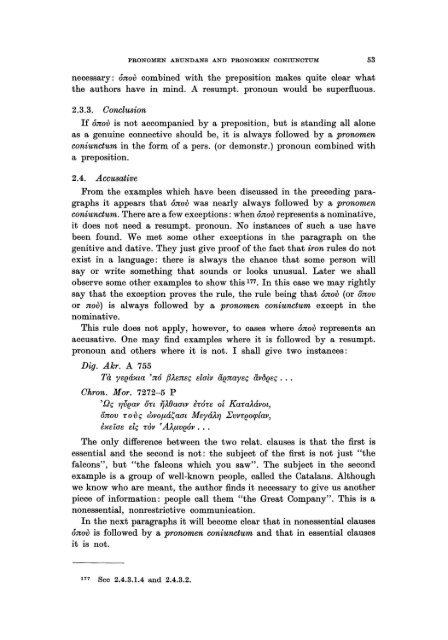Pronomen Abundans and Pronomen Coniunctum. A ... - DWC
Pronomen Abundans and Pronomen Coniunctum. A ... - DWC
Pronomen Abundans and Pronomen Coniunctum. A ... - DWC
Create successful ePaper yourself
Turn your PDF publications into a flip-book with our unique Google optimized e-Paper software.
PRONOMEN ABUNDANS AND PRONOMEN CONIUNCTUM 53<br />
necessary: ÓJlOV combined with the preposition makes quite clear what<br />
the authors have in mind. A resumpt. pronoun would be superfluous.<br />
2.3.3. Conclusion<br />
If ÓJlOV is not accompanied by a preposition, but is st<strong>and</strong>ing all alone<br />
as a genuine connective should be, it is always followed by a pronomen<br />
coniunctum in the form of a pers. (or demonstr.) pronoun combined with<br />
a preposition.<br />
2.4. Accusative<br />
From the examples which have been discussed in the preceding paragraphs<br />
it appears that ÓJlOV was nearIy aiways followed by a pronomen<br />
coniunctum. There are a few exceptions : when ÓJlOV represents a nominative,<br />
it does not need a resumpt. pronoun. No instances of such a use have<br />
been found. We met some other exceptions in the paragraph on the<br />
genitive <strong>and</strong> dative. They just give proof of the fact that iron ruies do not<br />
exist in a language: there is always the chance that some person will<br />
say or write something that sounds or looks unusual. Later we shall<br />
observe some other examples to show th is 177. In this case we may rightly<br />
say that the exception proves the rule, the rule being that ÓJlOV (or ÖJlOV<br />
or Jlov) is always followed by a pronomen coniunctum except in the<br />
nominative.<br />
This rule does not apply, however, to cases where ÓJlOV represents an<br />
accusative. One may find examples where it is followed by a resumpt.<br />
pronoun <strong>and</strong> others where it is not. I shall give two instances:<br />
Dig. Akr. A 755<br />
Tà yeeá~ta > JlÓ fJ),meç elalv äeJlayeç dvbeeç . ..<br />
Chrono Mor. 7272-5 P<br />
> Qç rri5eav ön ij),(jaatv nore Ot Kam)'ávot,<br />
ÖJlOV rovç wvop,áCaat MeyáÄ'YJ Evvreorptav,<br />
è~e iae elç rov • A),p,veóv ...<br />
The only difference between the two relat. clauses is that the first is<br />
essential <strong>and</strong> the second is not: the subject of the first is not just "the<br />
falcons", but "the falcons which you saw". The subject in the second<br />
example is a group of well-known people, called the Catalans. Although<br />
we know who are meant, the author finds it necessary to give us another<br />
piece of information: peopie call them "the Great Company". This is a<br />
nonessential, nonrestrictive communication.<br />
In the next paragraphs it will become clear that in nonessential clauses<br />
ÓJlOV is followed by a pronomen coniunctum <strong>and</strong> that in essential clauses<br />
it is not.<br />
177 See 2.4.3.1.4 <strong>and</strong> 2.4.3.2.
















